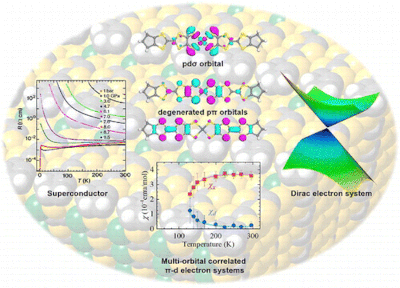Single-Component Molecular Conductors - Multi-Orbital Correlated π-d Electron Systems
A. Kobayashi, B. Zhou, R. Takagi, K. Miyagawa, S. Ishibashi, A. Kobayashi, T. Kawamura, E. Nishibori, and K. Kanoda, Bull. Chem. Soc. Jpn. 94, 2540 (2021).
Traditional molecular conductors are composed of more than two chemical species. Two prerequisites for the design of molecular metals have long been considered to be 1) forming of the electronic band and 2) existence of charge carriers created by the intermolecular charge transfer between the molecules constructing the band and other chemical species. On the other hand, a single-component molecular metal, [Ni(tmdt)2] (tmdt = trimethylenetetrathiafulvalenedithiolate), was developed in 2001; it is a planar nickel complex coordinated by the extended-TTF dithiolate ligands, tmdt from both sides. Since then, various types of single-component molecular conductors with a variety of extended-TTF dithiolate ligands have been developed. In this account, we briefly describe the recent progress in research on single-component molecular conductors. First, single-component molecular conductors in isostructural systems, [M(tmdt)2] (M = Ni, Pd, Pt, Au, and Cu) are described. Recent orbital-selective 13C and 1H NMR experiments have genealogically elucidated the differences in the electronic states and physical properties of these systems, that is, their various unusual phenomena are produced from their multi-orbital correlated π or π-d electron systems. Next, we describe [Ni(hfdt)2] (hfdt = bis(trifluoromethyl)tetrathiafulvalenedithiolate), the first single-component molecular superconductor, which was revealed by high-pressure resistivity measurements with a diamond anvil cell (DAC). The superconducting transition occurred around 7.5–8.7 GPa with a maximum Tc (onset temperature) of 5.5 K. Recent theoretical calculation has revealed that [Ni(hfdt)2] will be a new molecular Dirac electron system. In the final section, we briefly introduce molecular Dirac electron systems. Recently, a new series of semimetals, [M(dmdt)2] (M = Pt and Ni; dmdt = dimethyltetrathiafulvalenedithiolate) was synthesized. They belong to a three-dimensional ambient-pressure molecular massless Dirac electron system. The first-principles band structure calculations of [M(dmdt)2] (M = Pt and Ni) revealed that Dirac cones emerge along the a* direction and form Dirac nodal lines.
(Click figure for a larger image.)

